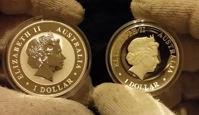Posted on July 22, 2021

By Paul Vanguard, for BullionMax.com
The first thing that most first-time gold buyers notice when browsing coins: the same coin is listed repeatedly, with quite different prices (even if they come from the same mintage). Sometimes we get polite emails pointing out our "mistake" in pricing. Sometimes not so polite.
As a public service to our customers, here's the source of the confusion…
Mints often create different versions of the same coin. These different versions are priced differently depending on how much effort went into making them.
There are three main categories: bullion, brilliant uncirculated and proof.
Here's an overview of the differences between these different types of coins.
Bullion coins are the most common, and generally the least expensive. They're called "bullion coins" because their value is derived almost exclusively from their gold and silver content.
That's not intended to malign bullion coins. The world's top mints use the same designs (sometimes the exact same dies) to make bullion and higher-grade coins.
Bullion coins are usually more affordable, commanding a lower premium over spot than higher-grade coins. Why? Simply because mints crank them out faster. You don't pay for the time mint employees spend thoroughly inspecting and hand-polishing bullion coins. On the other hand, bullion coins aren't treated like family heirlooms by the mints, either. You can expect a bullion coin to have blemishes, bag marks, or other cosmetic imperfections.
Even though bullion coins are a little higher over spot than bullion bars, a lot of people think they're a solid investment for a few reasons:
Generally speaking, bullion coins are for investors who buy based on metal content (also known as melt value) rather than collectors who buy for other reasons (like numismatic value).
Next up are brilliant uncirculated coins. You'll also see them described as "uncirculated" or, for acronym enthusiasts, "BU."
Brilliant uncirculated coins take about twice as long to strike (each) compared to bullion coins. That's partly because each of the coins is struck twice and partly because they are hand-finished, which gives them a greater degree of detail.
Brilliant uncirculated coins will cost more than bullion coins, most likely will be rarer, and are more likely to enjoy numismatic value above and beyond their precious metal content.
These coins are a good option for collectors who aren't yet ready to shell out big bucks for the highest-available grade of coin, the proof.
Proof coins are the most expensive and most meticulously crafted grade of coins. The name "proof" dates from a time when mints first did a "trial run" of their dies and equipment to make sure the coin met their expectations. The mints usually kept the first coin from a mintage as a kind of trophy. Over time, they started spending more time and energy getting that first coin absolutely perfect.
While other kinds of coins can come with a "proof" of authenticity, no other type of gold or silver coin gets the same kind of care, like good old-fashioned traditional craftsmanship much more than modern-day minting.
Proof coins get special treatment all the way through, which involves manual handling of the blanks, hand pressing the coin up to six times with less force to preserve detail, and much more attention being paid to the tiniest imperfection. Once a proof coin passes its multi-stage inspection, it's lovingly hand-polished to a mirror-bright finish to set off the incredible fineness of its details.
Obviously, there's a trade-off here… proof coins take four or five times longer than brilliant uncirculated coins, as much as ten times longer than bullion coins, to produce.
When a coin collector shows you their coins, especially gold and silver ones, they are almost guaranteed to be proof or uncirculated. Proof coins have the highest chances of appreciating in numismatic value based on limited supply, popularity, and other aftermarket factors.
Don't sleep on the old bullion ones, though: sales of these tend to go much smoother on both sides, and they always have a chance of becoming a collector's item that appreciates in value far past the spot price.
Paul Vanguard is a lifelong precious metals enthusiast and a proud member of the BullionMax team.